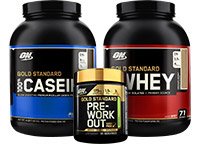
5 Ways To Increase Your Training Intensity
Physique changes occur when you challenge your body. Ramp up your workouts for better progress with these intensity techniques!
You're probably familiar with the words "training intensity." But what do they mean? To a kinesiologist, intensity is a way to determine how much energy your body is expending during exercise. It's a measure of your effort against your maximum capability. In other words, it's way to gauge power output.
Depending on the amount of energy you expend or the intensity of a workout, your body will use fuel differently. For example, high-intensity exercise will cause your body to use carbohydrates because of their quick energy production. Unfortunately, your stores of carbohydrates are limited and can deplete rather quickly, leaving you with an empty tank.
Research has shown that high-intensity exercise is a powerful method to increase your body's ability to rely on stored fat for fuel, which will allow you to work out longer, and it can have a positive impact on your body compostion.1
Increasing the intensity will not only help you burn through extra calories, it will challenge your cardiovascular and muscular systems in ways they may not be accustomed to. New challenges to your body generally turn into great physique and performance enhancements.
Using the following intensity increasers will help you keep your muscle mass high and your body fat low, all year round.
Use Heavy Weight
Your rep range should reflect your fitness goals. For strength goals, your sets should be built on 3-5 reps. For muscle-building goals, stick to 8-12 reps. For muscular endurance, try 12-15 reps. For hypertrophy (muscle-building) goals, the last couple of reps per set should be damn near impossible. In reality, a great way to determine if you're lifting heavy enough is to see if you're reaching failure on each set. If you can get to 15 reps easily, then those dumbbells are too light!
Never underestimate the power of heavy weight. If you're not using challenging weight, there's no way you're stressing your muscles enough to make any change. It takes power output to move weight, so make sure yours is on the high end!
Increase Your Time Under Tension
To grow, your muscles have to be stressed. The amount of stress you can provide on your muscles is important. If you train your muscles for too long, you run the risk of injury and overtraining. If you don't give them enough time under tension (TUT), you may be not be getting the gains you want.
TUT is the total amount of work you put on the muscle, or the total time your muscle resists weights during a set. You can change the length of your set for particular goals. For strength goals, the amount of TUT per set is about 20 seconds. For hypertrophy, you want to be somewhere around 40 seconds. For muscular endurance, you're looking at about 70 seconds.
To lengthen each rep, you can increase the eccentric portion of your lifts, boosting the amount of time your muscles work on each rep. You can also pause at peak contraction for 1-2 seconds instead of immediately lowering the weight.
If you're in that muscle-building range of 8-12 reps, each rep should last 4-5 seconds. You may not think slowing down your reps will have a big impact on your workout, but give it a try. I bet you'll feel some serious pain during and after.
One way to increase TUT is to use tempo training. Tempo refers to the speed at which you lift weights. It's usually denoted in numbers like this: 3:1:2:1. The first number is the eccentric, or lowering, portion of the lift. The second number is any pause at the midpoint. The third number is the concentric, or lifting, portion, and the fourth shows any pause at the top.
You can play with the tempo of your lifts in many different ways. You can slow down the eccentric portion, speed up the concentric, or increase the length of the pause at peak contraction. Or you can do the complete opposite.
Tempo training will give you more control over your lifts, making you a better lifter in the process. Tempo training will provide extra oomph for your workouts. Lengthy holds at the contraction and slow eccentric lifting can make your muscles scream!
Decrease Your Rest Periods
How much rest you give yourself between reps will dramatically affect the intensity of your workout. If you're a powerlifter, chances are you're giving yourself at least 3-5 minutes between sets in order to produce maximum energy during each lift. However, if you're training for hypertrophy, you can make your workouts pack a bigger fat-burning punch by decreasing the amount of rest you take between sets.
In general, I suggest keeping your rest periods between 30-60 seconds. That means you need to watch the clock and pay attention to what you're doing between sets. There's no time to be talking to your friends, looking at your Instagram feed, or taking selfies. You should need those 30-60 seconds to recover and maybe grab a sip of water or BCAAs.
If you find that 60 seconds is too long, and you're not getting the cardiovascular benefit, drop your rest to 45 or 30 seconds. It's your job to pay attention to how your body reacts and how you feel. If you are still breathing hard by the time you hit your next set and can't complete the reps, you may need to give yourself a little more time. However, you shouldn't be resting so long that your heart rate returns to normal. Keep your heart rate high by resting just enough between sets so you feel fatigued, but not so fatigued you can't complete the work.
Use Supersets, Circuits, and Dropsets
Straight sets work well—don't get me wrong. Per exercise, 3-4 sets of 8-12 reps are definitely going to help you build muscle and lean out. However, there are ways to spice up those straight sets to increase your workout's intensity.
One of the best ways to make your workouts more intense is to perform supersets. Supersets involve performing two exercises, one right after the other, without rest. Going from one exercise to another without rest is a great way to get your heart and muscles pumping.
The same idea can be applied to many exercises. For example, you can do an entire workout as a circuit by performing five exercises, one after the other, without rest. Only rest when you complete the last exercise in the circuit. Training circuit-style often means you'll have to use a little less weight because the intensity is so high. It also means you're giving your body one hell of a cardio workout while you're pumping iron.
Another great way to increase intensity is to use dropsets. Perform your usual sets, but after completing the final rep on the final set, drop the weight stack and keep doing reps. You can do multiple drops in a set, or just do one. The point, though, is to take your muscles beyond failure. Stressing your muscles this way will help you achieve some epic gains.
Mentality
There's a distinct difference between somebody who wants it, and somebody who will actually do what it takes to get it. When you're in the gym, it's your job to keep your lifts heavy and your volume high enough to make your workouts difficult. If you're continually undertaking mediocre workouts that don't challenge you, progress will remain elusive.
Your workouts are supposed to be difficult. You don't need to leave the gym every day feeling wrecked, but you do need to leave the gym every day feeling fatigued, perhaps even depleted. If you want change to happen, you need to put your muscles through stress they're not accustomed to.
The Next Step
When using these intensity-boosting techniques, try implementing them one at a time. For instance, if you haven't tried increasing the TUT of your sets, start there. See how it feels to lengthen your reps, and see what progress you can make with that technique in 4-6 weeks. Once you've done that, see what happens if you decrease your rest periods.
Always take stock of your workouts and how your body feels. If you notice great changes occurring, keep working. If you don't like something, make a change. Fitness is personal—make your workouts fit your needs!
Reference
- Gibala, M. J., Little, J. P., MacDonald, M. J., & Hawley, J. A. (2012). Physiological adaptations to low-volume, high-intensity interval training in health and disease. The Journal of Physiology, 590(5), 1077-1084.



